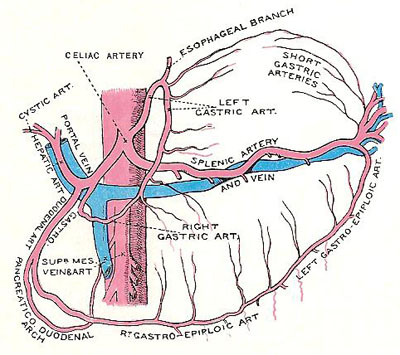hepatic artery

Celiac artery and its branches including the hepatic artery.
The hepatic artery runs behind the lesser sac toward the right and slightly downward along the upper border of the pancreas to reach the first part of the duodenum. There, it curves forward below the opening into the lesser sac to enter the lesser omentum. It ascends in the omentum near its free border, in front of the portal vein and medial to the bile duct. Near the porta it divides into two terminal branches – the right left hepatic arteries – which enter the porta and sink into the corresponding lobes of the liver.
Branches of the hepatic artery
The branches of the hepatic artery, in their usual order of origin, are gastroduodenal, right gastric, duodenal, and the right and left terminal branches; and the right terminal branch gives off the cystic artery.
The gastroduodenal artery arises where the hepatic artery reaches the duodenum. It descends behind the first part of the duodenum immediately to the right of the lesser sac, first in front of the portal vein and then in a groove on the front of the neck of the pancreas; and it ends by dividing into the superior pancreaticoduodenal and the right gastroepiploic. It has no companion vein.
The superior pancreaticoduodenal is a small artery that curves downward between the head of the pancreas and duodenum, giving branches to both; the companion vein – which is often absent – ends in the superior mesenteric vein.
The right gastroepiploic artery runs toward the left between the anterior two layers of the greater omentum, near the lower border of the first half-inch of the duodenum and the lower border of the stomach; and it ends by anastomosing with the left artery. It sends numerous branches upward to the duodenum and the stomach and a few downward into the greater omentum. Its vein ends usually in the superior mesenteric.
The right gastric is a small artery that arises as the hepatic enters the lesser omentum. It runs toward the left, between the two layers of the lesser omentum, along the duodenum and the lesser curvature of the stomach (giving branches to them), and anastomoses with the left gastric artery. The right gastric vein lies alongside its artery and ends in the portal vein.
The pre-pyloric vein is a small vessel that connects the right gastric and gastroepiploic veins. It runs downward over the front of the pylorus, and can be seen shining trough the peritoneal coat of the pylorus in the living abdomen. Its importance is surgical: when the pylorus is obscured by diseased thickening of adjoining parts of the stomach and duodenum, this vein is a means of recognizing which part of the thickening is the pylorus.
A duodenal branch may arise from the hepatic artery in the lesser omentum, and descend to supply the end of the first part of the duodenum and the beginning of the second part.
The cystic artery arises from the right terminal branch of the hepatic, runs along the cystic duct to the gall bladder, and divides into two branches which ramify on its two surfaces. The cystic vein ends in the right branch of the portal vein.


